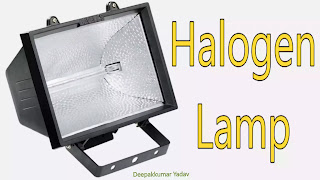Halogen Lamps
Halogen lamps are developed filament lamps and are free from drawbacks of filament lamps.
Drawbacks for filament lamps :
Halogen lamps are developed filament lamps and are free from drawbacks of filament lamps.
Halogen lamp Principle : “Amount of radiations in visible spectrum increases as temperature of incandescent material increases upto 6000°C absolute".
Therefore, any material will be suitable and will have high radiating efficiency which has high melting point. Carbon and tungsten are better choices for filament lamp, having melting point of 3500°C and 34001 respectively.Drawbacks for filament lamps :
- Carbon vaporizes very fast beyond its working temperature of 1800°C large electrical input is required to produce given C.P. (Candle Power). Thus efficiency is low about 3 lumen/watt.
- Vapourization of carbon results into blackening of the inside of the bulb. This phenomenon is more pronounced with carbon that in tungsten employed bulbs.
- In 1959, along with the argon gas filling, iodine was added and the drawback was eliminated
- The evaporated tungsten of filament on reaching the relatively low temperature near the wall of the envelope forms a compound of tungsten iodine and is represented by the chemical reaction.
W + nx → WXn
Where, W → Tungsten
x → Halogen
n → Number of atoms.
- Tungsten iodine which is very volatile suffers thermal diffusion in the direction of filament and on reaching the filament at high temperature it decomposes me the tungsten and halogen as follows :
WXn → W + nX
- The tungsten so released is deposited back on the filament. Iodine, therefore, works as a transport gas. In this way evaporated tungsten is restored to the filament by iodine regenerative cycle.
- In order that regenerative cycle should function properly, it is necessary to maintain relatively high bulb wall temperatures of 250°C. For this reason quartz is chosen as the envelope material and its size is kept very small, and quartz also facilitates high gas filling pressure, which is capable of giving higher light output.
- Iodine being corrosive in nature created problem during filling. So CH3Br was used which was easy to fill; non-corrosive in nature and has less atomic weight than that of iodine.
- There are two types of mains voltage tungsten halogen lamp :
(a) Single ended.
(b) Double ended.
(a) Single ended halogen lamps :
- Single ended halogen lamps have a compact filament inside a quartz envelope, which can be clear or frosted (achieved by sandblasting the outer surface of the envelope). They have caps to fit domestic lamp holders.
(b) Double ended halogen lamps :
- Double ended halogen lamps are tubular lamps with , contact at each end . These contacts are attached to a short pin emerging from the pinch seal , and recessed into a ceramic insulator.
- It is available in miniature size, single ended or double ended lamps.
- No blackening of lamps.
- It has higher lumen output 22-33 lumens/watt and high operating temperature.
- It has longer life about 2000 hrs and approximately double that of filament lamp
- It has better colour radiation.
- Available in convenient size
- Temperature under working condition is very high.
- Bulb surface is sensitive due to presence of liquid.
- Not as efficient as high intensity discharge lamps.
- These are used in public halls, factories, photo-film OHP, Car lighting, large gardens, airport runways, sport halls, photo films, T.V., studios etc.


